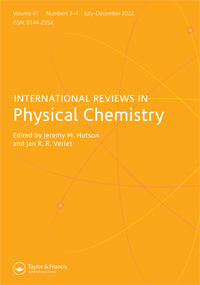非调和分子振动的图解理论
IF 2.5
2区 化学
Q3 CHEMISTRY, PHYSICAL
引用次数: 8
摘要
本文综述了本实验室在分子非调和振动结构的多体量子力学计算领域的最新进展。我们的扩展尺寸振动自洽场(XVSCF)和扩展尺寸二阶多体微扰(XVMP2)方法,不同于它们的父方法(VSCF和VMP2),用能量和戴森自能的图解公式定义,导致零点能量和非谐波振动频率的明显尺寸一致表达式的计算效率更高。XVSCF的有效单模势是二次的,因此每个模态的Schrödinger方程可以解析求解,不像VSCF需要对更复杂的单模势进行波函数的基集展开;在热力学极限下,VSCF的势及其极小值(非调和几何)可以简化为二次势及其极小值(也可以解析地给出)。通过使用频率相关的自能自洽地求解Dyson方程,XVMP2能够在存在强非谐波共振的情况下计算基元的非谐波频率以及组合和泛音,而无需多参考或准简并公式,这往往是非尺寸一致的。为了消除XVSCF和XVMP2的计算瓶颈,即高阶力常数计算,我们开发了替代算法,其中将图解方程重刻成少量高维积分,然后使用Metropolis蒙特卡罗(MC)方法进行随机计算。这些MC-XVSCF和MC-XVMP2方法不仅消除了力常数评估或存储的需要,而且根据其重要性考虑到力常数的无限顺序。它是量子蒙特卡罗的一个新分支,可以直接计算频率(激励能),而不存在固定节点误差。本文章由计算机程序翻译,如有差异,请以英文原文为准。
Diagrammatic theories of anharmonic molecular vibrations
In this review, we summarise recent developments in our laboratory in the field of many-body quantum-mechanical calculations of the anharmonic vibrational structure of molecules. Our size-extensive vibrational self-consistent field (XVSCF) and size-extensive second-order many-body perturbation (XVMP2) methods are, unlike their parent methods (VSCF and VMP2), defined in diagrammatic formulations of the energies and Dyson self-energies, leading to manifestly size-consistent expressions for zero-point energies and anharmonic vibrational frequencies calculable with much greater efficiency. The effective one-mode potentials of XVSCF are quadratic and hence the Schrödinger equation for each mode can be solved analytically, unlike VSCF, where a basis-set expansion of wave functions on more complex one-mode potentials need to be performed; VSCF potentials and their minima (anharmonic geometry) are shown to reduce to the quadratic potentials and their minima (also given analytically) of XVSCF in the thermodynamic limit. By self-consistently solving the Dyson equation with frequency-dependent self-energies, XVMP2 has the ability to calculate anharmonic frequencies of fundamentals as well as combinations and overtones in the presence of strong anharmonic resonance without a multireference or quasi-degenerate formulation, which tends to be non-size-consistent. To eliminate the computational bottleneck of XVSCF and XVMP2, which is the high-rank force-constant evaluation, we have developed alternative algorithms in which the diagrammatic equations are recast as a small number of high-dimensional integrals and then evaluated stochastically using a Metropolis Monte Carlo (MC) method. These MC-XVSCF and MC-XVMP2 methods not only remove the need for force-constant evaluation or storage, but also take into account force constants of up to infinite order according to their importance. They are a new branch of quantum Monte Carlo which can calculate frequencies (excitation energies) directly without fixed-node errors.
求助全文
通过发布文献求助,成功后即可免费获取论文全文。
去求助
来源期刊
CiteScore
14.20
自引率
1.60%
发文量
5
审稿时长
1 months
期刊介绍:
International Reviews in Physical Chemistry publishes review articles describing frontier research areas in physical chemistry. Internationally renowned scientists describe their own research in the wider context of the field. The articles are of interest not only to specialists but also to those wishing to read general and authoritative accounts of recent developments in physical chemistry, chemical physics and theoretical chemistry. The journal appeals to research workers, lecturers and research students alike.

 求助内容:
求助内容: 应助结果提醒方式:
应助结果提醒方式:


